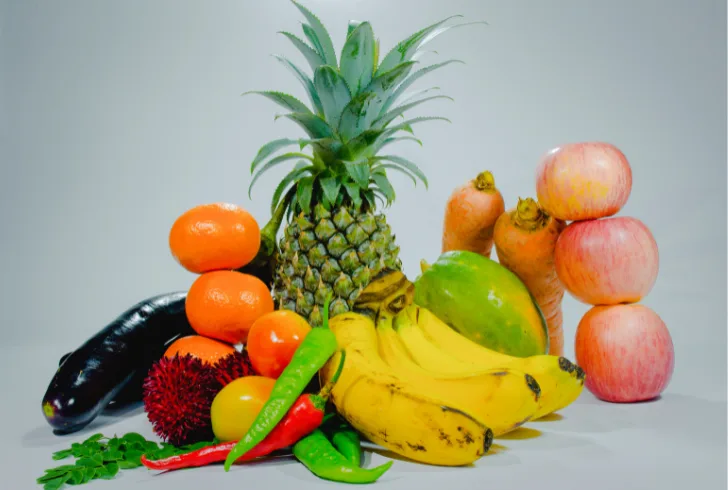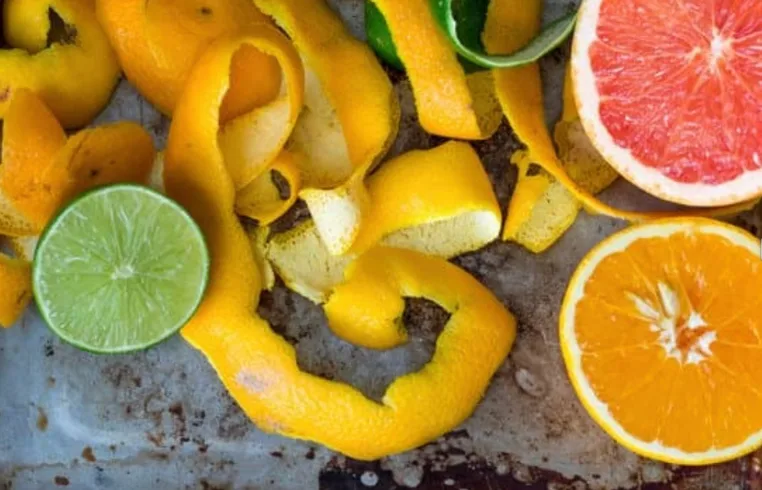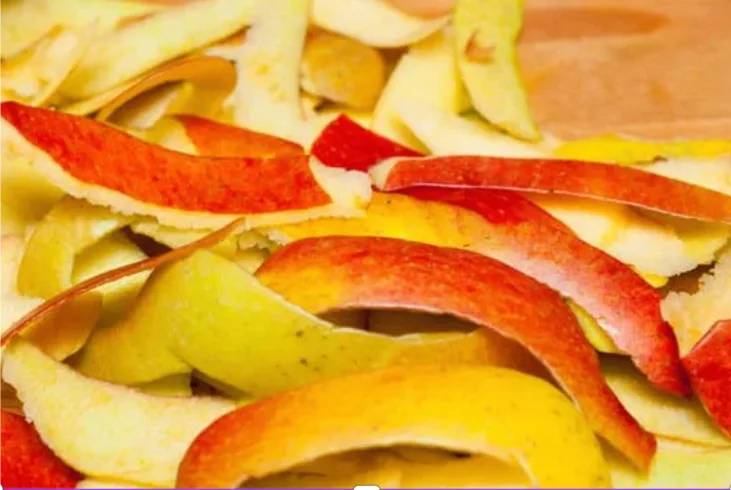Food is one of the basic needs of our life. Food contains nutritious elements that are beneficial for the growth of the body, and maintenance of the body’s energy. We eat various types of fruits and vegetables in our everyday life. And most people eat them by tossing the peels of the fruits and vegetables. But do you know these peels are filled with essential nutrients and health benefits?
Eating peels gives you extra nutrients to boost your body capacity and increase the body’s immune system. At wellhealthorganic.com, we’ll get to know how the peels are beneficial to our body. So, let’s dive into the details of eating peels for nutritional benefits, shall we?
Nutritional Composition of Common Fruit and Vegetable Peels

Before knowing why you should eat the peels, you need to know the nutritional compositions of these fruits and vegetables mentioned below:
- Apple Peels
The peels of an apple are the most nutrient part. Because apple peels are packed with 142% more vitamin A, 115% more vitamin C, 332% more vitamin K, 19% more potassium, and 20% more calcium than a peeled apple. So consuming apples with peels gives more nutrient value than eating them without peels.
- Banana Peels
Banana peels contain many nutrients and minerals. The banana peels are a good source of potassium (78.10mg/g), calcium (19.20mg/g), magnesium (76.20mg/g), sodium (24.30mg/g), iron(0.61mg/g), crude fiber (31.61mg/g), vitamin B6, vitamin B12. Dried banana peels contain 20%-30% fiber, and ripe banana peels contain up to 30% sugar.
- Pear Peels
Pear peels are rich in antioxidants, phenolic acids, polyphenols, vitamin C, anti-inflammatory terpenoids, and fiber (21%). Pear peels help with healing wounds faster, reducing cholesterol levels, and preventing heart disease.
- Grape Peels
Red grape skins contain an array of bioflavonoids (quercetin, catechins, flavonols, and anthocyanidins) and non-flavonoid polyphenols (acid derivatives). One important non-bioflavonoid in grape skin is called resveratrol.
- Orange Peels
Orange peels contain calcium (24.1 mg), riboflavin (0.014mg), vitamin C (16.5mg), folate (0.0015mg), fiber (1.59mg), pectin, thiamin, and polyphenols which helps to prevent chronic diseases like diabetes, Alzheimer’s disease, etc.
- Kiwi Peels
Kiwi peels have higher levels of vitamin E, vitamin C, and folate and are rich in fiber. Eating kiwis with peels will give more vitamin C than other fruits.
- Potato Peels
Potato peel has a good amount of dietary fiber (40%-50%), potassium (30%-40%), vitamin B6, riboflavin, and vitamin C, which are beneficial for the heart, skin, hair, and helps to improve the immune system.
- Sweet Potato Peels
Sweet potatoes are rich in fiber, vitamin A, vitamin C, potassium, magnesium, etc like a normal potato which helps to increase the metabolism of the body.
- Carrot Peels
Carrot peels are a good source of cations (92% or more) fiber, antioxidants, potassium, vitamin C, beta-carotene (a form of the vitamin), carotenoids (40% or more), etc. Carrot peels have more phenolic acids than root flesh. These are needed to maintain healthy eyes, skin, teeth, and bones and help to improve the immune system.
- Cucumber Peels
Cucumber peels contain a great amount of silica ( good for skin and health). 52g of a cucumber contains 0.026 mg of vitamin A, 1.5 mg of vitamin C, 0.15 mg of iron, 74 mg of potassium, and 8.3 mg of calcium. These peels contain no cholesterol or any saturated fat.
- Eggplant Peels
Certainly, eggplant peels are packed with big amounts of potassium, magnesium, iron, dietary fiber (43.3%), insoluble dietary fiber (29.31%), and zinc.
- Peach Peels
You can find approximately 3gm of fiber in large peach peels. As usual, if you eat peach peel or whole fruit with the skin on, you’ll get the most fiber. However, these fruit peels are a source of high antioxidants.
There are more edible peels such as apricots, berries, cherries, citrus fruits (grated or cooked), mushrooms, parsnip, peas, pears, plums, pepper, squash (if well cooked), zucchini, and asparagus.
Why You Should Eat Your Peels
After learning about the nutritional composition of some specified peels you must now know why you should eat these peels and what are the benefits of eating them.

Health Benefits of Eating Peels
- High in fiber
As you see in the previous section about nutritional composition, there’s no doubt that peels are a mine of health benefits. Whether it’s fruit skin or veggie skin they are loaded with high fiber. You know fiber helps digestion and healthy weight and prevents heart disease. For example, a simple apple peel contains 4.4gm of fiber.
We don’t usually eat banana peels but they are packed with potassium, fiber, and amino acids. Those simple peels contain 4 times more fiber than whole fruit. Not only that, they have components like tangerine and nobiletin. These have the power to fight cancer, diabetes, and inflammatory issues in our bodies. They can lower LDL cholesterol more effectively than prescribed drugs.
- Rich in vitamins and antioxidants
Other than fiber, peels are rich in vitamins and antioxidants. For instance, potato peels singly have iron, potassium, calcium, Vitamin C, and vitamin B6. This can be effective in your regular diet as well as nutrient intake. Also maintaining a good immune system, and proper cellular function – leads to good health maintenance.
On the other hand, kiwi contains high levels of Vitamin C and antioxidants along with fiber. It can enhance your nutrient intake. Apart from peels, watermelon rinds contain high citrulline amino acid which can help widen blood vessels to promote circulation.
A veggie skin, we often throw it away– contains more antioxidants than that veggie itself. Yes, I’m talking about onion peels, which are packed with quercetin – lower BP and prevent arterial plaque.
- Natural weight management
The peels are rich in so many healthy nutrients. Eating fruits and vegetables with peels will make your stomach full after having a meal which will eventually help you to lessen your hunger and change your overeating habits with a healthy diet routine. It will later lead you to keep your body in good shape.
- Good for eyesight
Vitamin A, vitamin C, and vitamin E; these vitamins play a vital role in keeping the eyesight healthy. Vitamin A allows the eyes to adjust in low-light conditions. However, a lack of vitamin A in the body can lead a person to night blindness (Nyctalopia). Vitamin C and Vitamin E helps to reduce the development of cataracts. Apples, oranges, carrots, sweet potatoes, etc are good sources of these vitamins for maintaining healthy eyes.
- Fight with cancer-cause properties
Cancer is increasingly becoming one of the most deadly causes of death in the world. The researchers found that eating foods with high levels of antioxidant activities and cytotoxicity in a daily intake can prevent cancer. The peels of fruits and vegetables that contain antioxidants for example carrot skins, apple peels, and pear peels allow to lower the risk of chronic disease like diabetes. They also protect the body from inflammation and free radical damage.
- Natural remedies & skincare
Peels have been used as natural remedies for a long period. Apple peels can be used as toner to make the skin look more shiny and give a youthful complexion.
Banana peel helps to moisturize the skin and helps to reduce pain from insect bites. Orange peels help eliminate dead skin cells and reduce black spots. Potato peels are used for reducing dark circles under the eyes.
In addition, papaya peels and the citric acid in lemon peels help to lighten the skin and make it look more natural and glossy.
Environmental Impact of Eating Peels
You must be wondering if eating peels can create effects on the environment. Yes, this does create an environmental impact. Let’s look at some key factors of this topic.
- Reducing food waste
Eating fruits and vegetables with peels can help reduce food waste and you can intake most of the nutrients from the groceries that can save you from spending more money. It is a matter of concern that about one-third of food is wasted across the world. Eating peels can prevent greenhouse gas emissions. If you don’t want to eat peels then use them as a fertilizer to enrich the soil.
- Sustainability practices
Eating peels minimizes food waste and makes full use of fruits and vegetables. People should be encouraged to build the habit of not throwing these peels full of nutrients and healthy benefits. Sustainability practices such as eating peels can prevent environmental degradation and make a balanced economic system.
- Cost-effectiveness
Eating peels can help you reduce spending money on your food. If you consume the maximum amount from the groceries you bought it will minimize the spending cost and get more nutrients at the same time. Eating peels also helps you to increase your savings.
How to Prepare and Eat Peels Safely

Before eating your peels, you should know the methods of eating the peels safely.
Washing and cleaning methods
Washing methods for the separate use of peels:
- First, wash your hands properly before cleaning the peels.
- Before consuming the peels, you should wash them with clean water.
- Use a brush to remove all specks of dirt and pesticides from them.
- Use a clean chopping board, peeler, and knife to prevent bacteria attack.
- Use vinegar or baking soda in water to wash them more deeply.
As for preparing the peels, you can use the boiling or baking method if you want to eat them. You can also blend them to get the paste to apply to your skin, and hair or make a puree to have it during your meals.
Organic vs non-organic produce
We should eat the peels of fresh fruits and vegetables to consume more beneficial nutrients for our health. But all the peels are not safe to eat. Between organic and non-organic produce, some people may say organic produce is better in nutrients and safer than non-organic produce. But in reality, pesticides are used in both organic and non-organic food. So, whether it is organic or non-organic, for safety, we should wash the fruits and vegetables thoroughly before consuming. In this way, the peels will also be safe to eat.
Creative Ways to Incorporate Peels into Your Diet

There are many ways to add the peels to your daily diet. Now, let’s talk about the ways to eat your peels.
- Smoothies and juices
Use a blending method to make juices and soups out of the peels of fruits and vegetables. This will add various flavors and tastes to your everyday meals. You can also make smoothies with the peels. Make sure that the peels are perfectly chopped to make smoothies and juices.
- Baking and cooking
Baking and cooking are another technique that helps to prepare the peels worth eating. Cooking them brings a new flavor to the meals. For example, to create a tangy taste in baking cookies, muffins, breads or cakes use orange or lemon zest. Also, use carrot peels and kiwis with peels to use these flavors in baking cake. You can also use the peels (banana peels) to make curry. Carrot peels, onion peels, potato peels, zucchini peels, etc can be used to make broth or soup.
- Snacks and salads
Peels as snacks or salads are the best things if you crave something crunchy or something refreshing. Apple peel chips and potato peel chips are both tasty and healthy as a snack. To make these chips all you need to do is preheat the oven to 400 F and bake them in the preheated oven for 15-20 minutes after coating them with the required salt, pepper, and oil.
After taking them out they should look crispy and golden brown which can be considered as ready to eat. Making chips from peels is easy and only takes some time.
You can also make salads from the peels for refreshments. Using orange or lemon peels for salad dressings gives a zesty flavor to it. Another good option to use the orange or lemon peels is to make their candy by boiling them to reduce bitterness and after drying them add sugar to make them sweet as a candy.
Potential Risks and Precautions
Before setting your mind on starting to eat the peels you need to be aware of some risks and precautions for it.
Pesticides and chemicals
Pesticides and chemicals in fruits and vegetables are a concerning matter. Some may think pesticides are only contained in the skins of fruits and vegetables but they can also affect the whole plant. For that reason, we should wash the non-organic produce to prevent removing all harmful chemicals from the fruits and vegetables. Using vinegar in water to wash them properly also helps to reduce the pesticides and chemicals. And by doing so, you won’t have to throw away the peels.
Allergic reactions
Many food sources cause allergies so doctors suggest their patients avoid those from digesting. Eating certain peels that are not suitable for the body can be concerning. People can have allergic reactions from consuming certain peels, for example, an allergic reaction to a chemical called limonene that is found in the peels of citrus fruits. You can avoid those that may cause an allergic reaction in your body and enjoy the rest of the peels that you can consume without any complications.
Bitter/Weird taste and texture
There are some toxic peels that are best not to eat. You should avoid some peels like oranges, lemon, grapefruit, melon, onion, garlic, pineapple, etc. These are best when they are peeled as some of these are hard to digest or bitter in taste or inedible or hard to cook.
Myths and Misconceptions about Eating Peels
There are numerous myths and misconceptions about eating peels. But obviously, they are not true at all. Truthfully speaking, the peels are not just waste, some of them are filled with rich nutritious elements.
Common myths debunked
We are going to talk about some common myths that we have been accustomed to for a long time.
Myth #1. Peeling before eating fruits and vegetables
Many people believe eating peeled fruits and vegetables will be good for health and well-being. They only eat the peeled part of the fruits and vegetables as they believe the peels cannot be eaten and throw them away as trash. Yes, some peels like oranges, lemons, etc cannot be eaten directly but they can be used in various ways to enrich the daily meal. Not only is eating the peels beneficial, but also using them for various purposes for example making them useful for skincare.
Myth #2. Peels of fruits and vegetables are full of pesticides and chemicals and they are harmful
Many people don’t take risks by digesting peels full of pesticides. Based on the research that the USDA released, 99% of the samples used in the research contained pesticide residue below the EPA’s threshold level. So it is proven that eating peels of fruits and vegetables is safe and healthy.
Myth #3. Only peels of organic produce are safe to digest
Another misconception is that only the peels of organic produce are safe from pesticides but it is not true. Like non-organic produce, organic produce can also be harmful to people. Organic produce can be grown by using pesticides and chemicals. To prevent these chemicals from going inside our bodies, we should use the washing, cleaning, and preparing process.
Scientific Studies on the Benefits of Peels
Many researchers and scientists have been studying this topic since the early days. And they have proven that the peels are not just to throw away, they contain a sufficient amount of vitamins, fibers, and antioxidants. They also found that peels play a vital part as an aid for many diseases like diabetes, heart disease, etc. The scientific studies also agree with the doctors and nutritionists on the fact that the peels of fruits and vegetables are essential for a balanced diet.
Expert Opinions on Eating Peels

In this section, we’ll discuss nutritionists’ and environmental experts’ points of view on eating peels.
Nutritionists’ perspectives
Nutritionists always consider that consuming peels is good for improving the digestive system. The peels are high in fiber and vitamins. In addition to having a strong digestive system, eating the peels can also help maintain healthy internal systems.
Environmental experts’ views
Environmental experts think that peels are not as harmful as plastic bags, but they can cause climate change and affect the environment. According to the Food Agriculture Organization, uneaten food including the peels that are thrown away is responsible for greenhouse gas emissions (cause 9-10% of emissions).
A report published by New Zealand showed that only people with an amount of less than 6 million waste about 985 tonnes of fruit peels and more than 10,000 tonnes of vegetable peels. So, peels should not be wasted to save the environment from climate change.
Frequently Asked Questions
Can you eat any fruit or vegetable peel?
Yes, you can eat edible peels like apples, bananas, kiwis, cucumbers, grapes, pears, potatoes, peaches, carrots, berries, plums, eggplant, etc. Because these peels are full of minerals, a variety of vitamins, fiber, antioxidants, etc. But you should avoid eating bitter, toxic, or inedible peels like pineapple, melon, onion, garlic, orange, etc.
What’s the best way to store peels?
There are various ways to store peels. You can store them safely in a refrigerator by sealing them in a container. Another way is to use sugar syrup and vinegar. Drying the peels or containing them like pickles can also be a way to store them.
Conclusion
Now you have learned the importance and some pros and cons of eating peels for a healthy life, shared from wellhealthorganic.com. By understanding the significant benefits of the peels of fruits and vegetables, you should embrace them to build a healthy and balanced lifestyle. Rather than wasting these peels, adding them to various recipes in your diet will simply but effectively boost your health and bring happiness to your life.